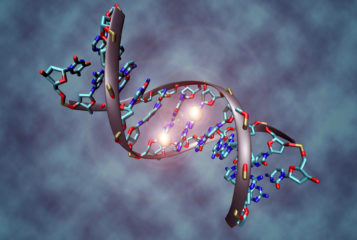Last week saw a lot of media interest around a US study published in Nature Neuroscience reporting the transgenerational effects of fear-conditioning in mice (see BioNews 733).
The paper (1), by Dr Brian Dias and Professor Kerry Ressler from Emory University, Georgia, is important for two reasons. It addresses constitutional fearfulness that is relevant to phobias, anxiety and post-traumatic stress disorders, plus the controversial subject of transmission of the 'memory' of ancestral experience (literally shocking in this case) down the generations. The study adds to the growing evidence from animal experiments for a phenomenon that we can broadly term transgenerational responses (TGR). However, this was a particularly 'clean', well-controlled experiment with surprising results - not only did the fearful behaviour manifest in offspring and grand-offspring, but they also inherited the associated structural changes in their nervous system.
The starting point was to fear-condition adult male mice by giving them a mild electric shock to the footpad at the same time as presenting a very specific odour (acetophenone) that they had never experienced before. As expected, these mice soon exhibited alarm when just presented with that specific smell, and also showed the expected increase in the specific odorant receptors and olfactory sensory neurons in the pathway from nose to brain.
So specific are these odorant receptors (each coded by their own gene) that the researchers could use a 'control' odour and they could even distinguish the associated neurological changes with this from those associated with acetophenone. Here we have a system where the causal link between exposure and response (increased sensitivity to acetophenone, but not the control odour) was understood at the cellular and molecular-genetic level. This is very different from TGR experiments on, for example, ancestral high fat diet and tendency to diabetes down the generations, where the causal pathways between exposure and response are still poorly understood.
Dias and Ressler wanted to test whether the hypersensitivity to acetophenone was biologically (rather than socially) transmitted down the male line to grandsons, and so went to extreme lengths to ensure there was no chance of the offspring learning to fear the smell from their parents. It may be that wild mice learn to fear the smell of fox urine from their parents' reaction as well as by other routes of transmission. Remarkably, the sons and grandsons of the acetophenone-conditioned males had an increased sensitivity to this odour even though they had never smelt it before, and furthermore they had also inherited the associated neurological changes.
Next, they looked at the sperm DNA of the fear-conditioned mice to check the Olfr 151 gene which codes for the specific odorant receptor for acetophenone. They found an epigenetic change: reduced methylation at one particular DNA site in the Olfr 151 gene. This is suggestive, but not proof, that the transmission of the increased sensitivity to acetophenone to their sons is through an epigenetic signal carried in the sperm. Such an epigenetic mechanism does not change the DNA sequence, but can lead to enduring changes in gene activity that in turn can change the structure or workings of the organism.
How frightened were the offspring and grand-offspring mice when this strange new odour was presented? We don't know. Only the sensitivity to acetophenone was actually measured, and assessing fearfulness per se is less easy to do. But that does not detract from the importance of this clear demonstration of TGR, free of confounding transmission through social imitation and learning.
Is it relevant to wild mice and humans? I think so. This experiment is not entirely removed from real life. Some way of forewarning the next generation of an olfactory danger signal may well have evolved in mice, and experiments over the last decade have shown, in line with common belief, that smell is important in human fear. Researchers in the Netherlands have demonstrated that, irrespective of confirmatory or contradictory audiovisual information, olfactory fear signals produced by senders induced fear in receivers outside of conscious access (2).
Studies have demonstrated the phenomenon, but not yet the mechanism of TGR in humans (3). For example, research in Sweden showed that the paternal grandparents' food supply at particular times in their childhood was associated with longevity in the grandchildren. Despite the elegant mouse experiment described above, it is important to emphasise that TGRs are not confined to 'inheritance of acquired characteristics' with the same feature in each generation. A Bristol study showed that men who started smoking cigarettes before their puberty are more likely to have future sons with obesity in adolescence compared to those who started smoking later, yet those smoking fathers were thin. It is also worth remembering that TGRs can be for better or worse.
It is high time TGR is taken seriously in epidemiology, both as a potential contributor to human constitutional variation in basic human biological research and in public health research. I suspect we will not understand the rise in neuropsychiatric disorders or obesity, diabetes and metabolic disruptions generally without taking a multigenerational approach.
Sources and References
-
1) Dias B and Ressler K. Parental olfactory experience influences behavior and neural structure in subsequent generations.
-
2) de Groot JH, Semin GR, Smeets MA. I Can See, Hear, and Smell Your Fear: Comparing Olfactory and Audiovisual Media in Fear Communication.
-
3) Grossniklaus U, Kelly B, Ferguson-Smith AC, Pembrey M, Lindquist S. Transgenerational epigenetic inheritance: how important is it?






Leave a Reply
You must be logged in to post a comment.